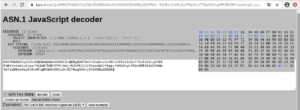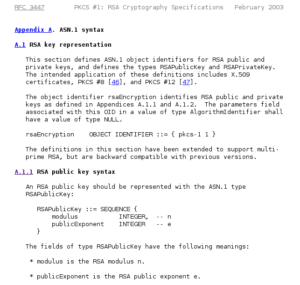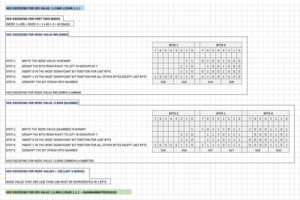Read that f… RFC 1421 : Privacy Enhancement for Internet Electronic Mail
and follow those precious links :
https://lapo.it/asn1js
https://docs.microsoft.com/en-us/windows/win32/seccertenroll/about-encoded-length-and-value-bytes
http://javadoc.iaik.tugraz.at/iaik_jce/current/iaik/x509/PublicKeyInfo.html
https://medium.com/@bn121rajesh/understanding-rsa-public-key-70d900b1033c
# Generate 1024 bit Private key $ openssl genrsa -out myprivate.pem 1024 # Separate the public part from the Private key file. $ openssl rsa -in myprivate.pem -pubout > mypublic.pem # Display the contents of private key $ cat myprivate.pem -----BEGIN RSA PRIVATE KEY----- MIICXQIBAAKBgQDRFNU++93aEvz3cV8LSUP9ib3iUxT7SufdVXcgVFK9M3BYzvro A1uO/parFOJABTkNhTPPP/6mjrU2CPEZJ1zIkpaSNJrrhpp/rNMO9nyLYPGs9Mfd BiWUPmHW5mY1oD0ye4my0tEsHOlgHC8AhA8OtiHr6IY0agXmH/y5YmSWbwIDAQAB AoGAAj/IH3pUI6FqqTrF+/gYzCRsL4AXTLC8l8vwkR93GGPyRHJNjqtik8I3WrXJ zUiBGZ0iNouIsL/+QQuNlGiw/c5i2X3nTntREDS9xs2M0x+MWD/5qI1sn0Qk0HNP BbDczlvO8wXNFGIHiTiPVEawoeNwhMqJDyGcbsEOZp2pLokCQQDvlMBU6dOeOP9a jnENFSlrvzNR0nugFeoGmfq6s4Czz2QtUd9baKqBfEBSdJskwFVHgxbFA1Dc7iFu rJkoQEeFAkEA32j9ibSVryxLvWUZngKNwo2xE+wcYDAYVBMsYC3OBU3FXhVkFD06 ZVnJsY/4bd2VdQI+bI2KV99aHutMJG2WYwJABMn2ZjweTMVa5VZ/kAFiSJMT1Yjd i7+kY+lkB6Na6T02BWnjixI2hkwThRJrn3pwufM2201Lqn7gEDRHA3T1eQJBAKZG 1RUNo6558HEo8vUIf4vCu33RaJkqkqDYmFmJHeISrQfGMfNiUrkmJ5iRR9w1ZExu /Bj9C281XDTQ+Z3PNnMCQQCan+pvj0OZH6o0PAMJGBBwRECPpfZ6mUjwA2YD3g61 MHjtIYmKKGmn64Qs8zQ4mNEDboQqyaov3Ij/I6c0ZQlc -----END RSA PRIVATE KEY-----
Privacy Enhanced Mail (PEM)
Privacy Enhanced Mail (PEM) is a Base64 encoded Distinguished Encoding Rules(DER)
PEM file is human readable as it uses 64 printable characters for encoding.
It is easy to share PEM file.
Display the contents of public key PEM file
# Display the contents of public key PEM file $ cat mypublic.pem -----BEGIN PUBLIC KEY----- MIGfMA0GCSqGSIb3DQEBAQUAA4GNADCBiQKBgQDRFNU++93aEvz3cV8LSUP9ib3i UxT7SufdVXcgVFK9M3BYzvroA1uO/parFOJABTkNhTPPP/6mjrU2CPEZJ1zIkpaS NJrrhpp/rNMO9nyLYPGs9MfdBiWUPmHW5mY1oD0ye4my0tEsHOlgHC8AhA8OtiHr 6IY0agXmH/y5YmSWbwIDAQAB -----END PUBLIC KEY-----
Distinguished Encoding Rules (DER) format of public key
DER is encoded in Type-Length-Value (TLV) format.
DER is in binary format for PEM file and follows certain structure for public key.
# Convert PEM file to DER format using openssl rsa $ openssl rsa -pubin -inform PEM -in mypublic.pem -outform DER -out mypublic.der # Dump the DER file in hex format. $ xxd -g 1 -u mypublic.der | cut -c -57 00000000: 30 81 9F 30 0D 06 09 2A 86 48 86 F7 0D 01 01 01 00000010: 05 00 03 81 8D 00 30 81 89 02 81 81 00 D1 14 D5 00000020: 3E FB DD DA 12 FC F7 71 5F 0B 49 43 FD 89 BD E2 00000030: 53 14 FB 4A E7 DD 55 77 20 54 52 BD 33 70 58 CE 00000040: FA E8 03 5B 8E FE 96 AB 14 E2 40 05 39 0D 85 33 00000050: CF 3F FE A6 8E B5 36 08 F1 19 27 5C C8 92 96 92 00000060: 34 9A EB 86 9A 7F AC D3 0E F6 7C 8B 60 F1 AC F4 00000070: C7 DD 06 25 94 3E 61 D6 E6 66 35 A0 3D 32 7B 89 00000080: B2 D2 D1 2C 1C E9 60 1C 2F 00 84 0F 0E B6 21 EB 00000090: E8 86 34 6A 05 E6 1F FC B9 62 64 96 6F 02 03 01 000000a0: 00 01
Structured DER file content
1:30 81 9F // Type: 30 (SEQUENCE) Length: 0x9F 2:| 30 0D // Type: 30 (SEQUENCE) Length: 0x0D 3:| | 06 09 // Type: 06 (OBJECT_IDENTIFIER) Length: 0x09 4:| | - 2A 86 48 // 9 bytes OID value. HEX encoding of 5:| | - 86 F7 0D // 1.2.840.113549.1.1.1 6:| | - 01 01 01 7:| | 05 00 // Type: 05 (NULL) Length: 0x00 8:| 03 81 8D // Type: 03 (BIT STRING) Length: 0x8D 9:| | - 00 // Number of unused bits in last content byte 10:| | 30 81 89 // Type: 30 (SEQUENCE) Length: 0x89 11:| | | 02 81 81 // Type: 02 (INTEGER) Length: 0x81 12:| | | - 00 // Leading ZERO of integer 13:| | | - D1 14 D5 3E FB DD DA 12 FC F7 71 5F 0B 49 43 FD 14:| | | - 89 BD E2 53 14 FB 4A E7 DD 55 77 20 54 52 BD 33 15:| | | - 70 58 CE FA E8 03 5B 8E FE 96 AB 14 E2 40 05 39 16:| | | - 0D 85 33 CF 3F FE A6 8E B5 36 08 F1 19 27 5C C8 17:| | | - 92 96 92 34 9A EB 86 9A 7F AC D3 0E F6 7C 8B 60 18:| | | - F1 AC F4 C7 DD 06 25 94 3E 61 D6 E6 66 35 A0 3D 19:| | | - 32 7B 89 B2 D2 D1 2C 1C E9 60 1C 2F 00 84 0F 0E 20:| | | - B6 21 EB E8 86 34 6A 05 E6 1F FC B9 62 64 96 6F 21:| | | 02 03 // Type: 02 (INTEGER) Length: 0x3 22:| | | - 01 00 01 // Public Exponent. Hex for 65537
DER file contains Object Identifier, Modulus and Public exponent in HEX format.
Lines 4, 5, 6 is the HEX encoding of OID.
Lines 13 to 20 is the modulus (n).
Line 22 is the public exponent.
You can also have a look at Lapo ASN.1 javascript decoder :
Modulus and Public exponent from public key using openssl
# Get Modulus and Public exponent from public PEM file $ openssl rsa -pubin -inform PEM -text -noout < mypublic.pem Public-Key: (1024 bit) Modulus: 00:d1:14:d5:3e:fb:dd:da:12:fc:f7:71:5f:0b:49: 43:fd:89:bd:e2:53:14:fb:4a:e7:dd:55:77:20:54: 52:bd:33:70:58:ce:fa:e8:03:5b:8e:fe:96:ab:14: e2:40:05:39:0d:85:33:cf:3f:fe:a6:8e:b5:36:08: f1:19:27:5c:c8:92:96:92:34:9a:eb:86:9a:7f:ac: d3:0e:f6:7c:8b:60:f1:ac:f4:c7:dd:06:25:94:3e: 61:d6:e6:66:35:a0:3d:32:7b:89:b2:d2:d1:2c:1c: e9:60:1c:2f:00:84:0f:0e:b6:21:eb:e8:86:34:6a: 05:e6:1f:fc:b9:62:64:96:6f Exponent: 65537 (0x10001)
Exponent and modulus printed by openssl rsa matches with the Public exponent and modulus from DER file content.
More information on recommended syntax for interchanging RSA public keys between implementations is given in Appendix A.1.1 of rfc3447 ( PKCS#1);
Object Identifier
OID describes the object. It is a series of nodes separated by period.
OID Value: 1.2.840.113549.1.1.1
OID description: Identifier for RSA encryption for use with Public Key Cryptosystem One defined by RSA Inc.
OID Encoding rules:
1 – The first two nodes of the OID are encoded onto a single byte. The first node is multiplied by the decimal 40 and the result is added to the value of the second node.
2 – Node values less than or equal to 127 are encoded on one byte.
3 – Node values greater than or equal to 128 are encoded on multiple bytes. Bit 7 of all bytes except the rightmost byte is set to one. Bits 0 through 6 of each byte contains the encoded value.
Representing length in ASN.1 encoding
If number of value bytes is < 128 (0x80) then length is represented in 1 byte. In this case most significant bit is 0. (Ex: Line 2: 0x81=10000001 => 1 octet, Line 3 in structured DER content above)
If number of value bytes is >= 128 (0x80) then length is represented in multiple bytes. Most significant bit (bit 7) of first byte is 1 indicating multiple byte length. Bits 0–6 represent number of subsequent bytes for length. (Ex: Line 1: 0x82=10000010 => 2 octets, Line 4 in structured DER content above)
References
DER encoding of ASN.1 types (MSDN)
Public Key Info structure (Java doc)
[ajout de août 2021 suite plaintes]
– Mais du coup … tu n’as pas répondu la question ?
[lm] C’est pas faux, mais si tu révises le fonctionnement de l’encodage base 64, à partir d’un contenu DER qui commence toujours par la même syntaxe:
xxd -r -p <<<30819F | base64
MIGf




